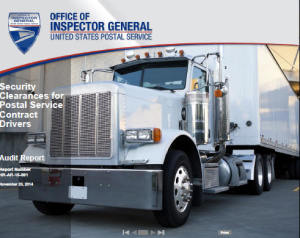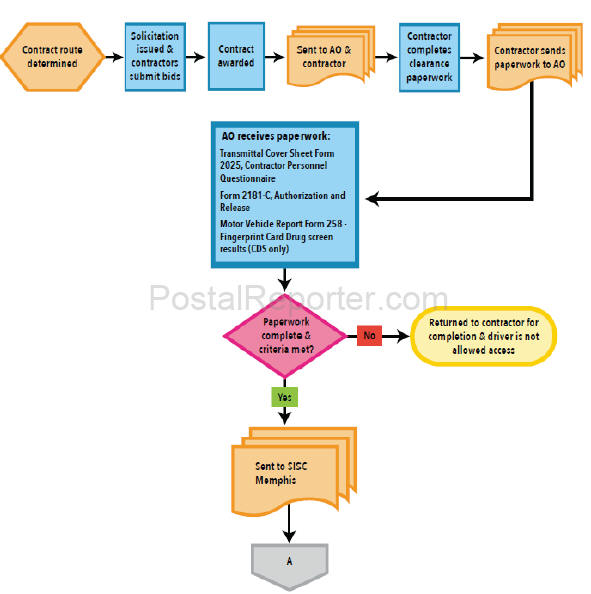USPS OIG: Security Clearances for Postal Service Contract Drivers
 This report presents the results of our self-initiated audit of Security Clearances for U.S. Postal Service Contract Drivers (Project Number 14YG008HR000). Our objectives were to determine whether Postal Service officials issued security clearances to contract drivers in accordance with policy and assess controls over the contract driver security clearance process. See Appendix A for additional information about this audit.
This report presents the results of our self-initiated audit of Security Clearances for U.S. Postal Service Contract Drivers (Project Number 14YG008HR000). Our objectives were to determine whether Postal Service officials issued security clearances to contract drivers in accordance with policy and assess controls over the contract driver security clearance process. See Appendix A for additional information about this audit.
The Postal Service is obligated to maintain the security of the mail and preserve the public’s trust. It must also ensure the public is confident in the reliability and integrity of Postal Service personnel, including contractors. The Postal Service must carefully screen its potential employees to make sure their conduct will reflect favorably on the organization.
The chief postal inspector or a designee is responsible for the adjudication of security clearances. If an individual needs a security clearance, the type granted will depend on the sensitivity of the individual’s Postal Service position. The Postal Inspection Service’s Security Investigations Service Center (SISC) oversees the security clearance process for regular and contract Postal Service personnel. See Appendix B for additional information on the security clearance process for contract drivers.
As of March 3, 2014, there were 14,524 contract delivery service1 (CDS), combination route,2 and highway contract route3 (HCR) contracts (see Figure 1). Each contract could have one or more drivers. All drivers must obtain a non-sensitive clearance because they handle mail and have access to Postal Service facilities. The SISC in Memphis, TN, issues non-sensitive clearances, which must be renewed every 4 years. About 4,200 administrative officials (AO) were designated by five contracting officers (CO),4 who report to Supply Management, to supervise and administer mail transportation contracts and related services by suppliers. The AOs are responsible for obtaining clearance documents from contract drivers and submitting them to the SISC, as well as ensuring drivers have the appropriate clearance.
Conclusion
Postal Service personnel, including contract drivers, did not always comply with security clearance requirements, and controls over the process were not adequate. Specifically, contract drivers did not always have a valid security clearance and were not always re-screened every 4 years, as required. Insufficient controls over contract driver security clearances increase the safety and security risks to Postal Service personnel, customers, mail, and assets, which could negatively impact the Postal Service’s brand.
Security Clearances
Postal Service personnel, including contract drivers, did not always comply with security clearance requirements, and controls over the process were not adequate.5 Specifically, of at least 14,524 contract drivers, 4,502 (31 percent) did not have a valid security clearance. Of the 4,502 contract drivers, security clearances for 2,566 (57 percent) had expired (see Figure 2). In one instance, a contract driver had his clearance rescinded in September 2010 but he continued to work until September 2011.
Further, many contracts were renewed and some were renewed multiple times even though drivers were not in compliance with security clearance requirements or had never obtained the proper clearance. Finally, of 14,524 contract driver security clearance files, 5,664 (39 percent) were either not maintained at all or did not contain the required documentation.
Lastly, we judgmentally selected and reviewed 1576 contract driver badges and found 51 (33 percent) with expiration dates that did not match security clearance expiration dates. Badge expiration dates for contract drivers must coincide with security clearance expiration dates.
According to Postal Service policy7 and contract terms, contract drivers must obtain a non-sensitive clearance, which must be renewed every 4 years. The CO plays an essential role in ensuring the Postal Service and suppliers comply with contract terms and conditions. The AO is responsible directly to the CO in administering the contracts so the Postal Service receives the best possible service and contract performance. According to contracting officials, the AOs are supposed to ensure contract drivers have the appropriate security clearance. In addition, the AOs must maintain security clearance files, including Postal Service Form 2025, Contract Personnel Questionnaire and notification from the SISC stating that it granted the security clearance. The deficiencies we identified occurred for the following reasons:
- Management did not have sufficient controls, such as procedures for tracking and monitoring clearances and ensuring that contract drivers were obtaining security clearances.
- There are about 4,200 AOs responsible for ensuring contract drivers have the appropriate security clearances; however, neither the Postal Service nor the Postal Inspection Service provided sufficient oversight or had controls in place to ensure the AOs and drivers complied with security clearance policies and procedures
- There were no mandatory training requirements and Postal Service personnel were not properly trained to obtain screening information from contract drivers and verify employment eligibility. We reviewed training records for 88 Postal Service personnel8 in six districts and found that 83 of them (94 percent) had no training regarding the security clearance process for contract drivers.
As a result, there are increased safety and security risks to the public, mail, and assets, which could negatively impact the Postal Service’s brand. For example, we identified recent news articles on theft by Postal Service contract drivers and found drivers did not always have the required security clearance at the time the offenses were committed. During a visit to a facility,the AO asked contract drivers to provide security clearance paperwork, including drug screening results for CDS drivers,9 which is required to obtain a clearance. After the AO’s request, one driver turned in his badge and quit rather than provide the requested drug screening results.
We recommended management establish formal procedures to track and monitor security clearances and notify appropriate personnel when clearances are not renewed. We also recommended management establish mandatory training requirements and a formal oversight process for contracting officers to validate contract drivers have security clearances when renewing contracts.
During our audit, postal officials took corrective actions to obtain security clearances for the contract drivers we identified who were not properly cleared.
